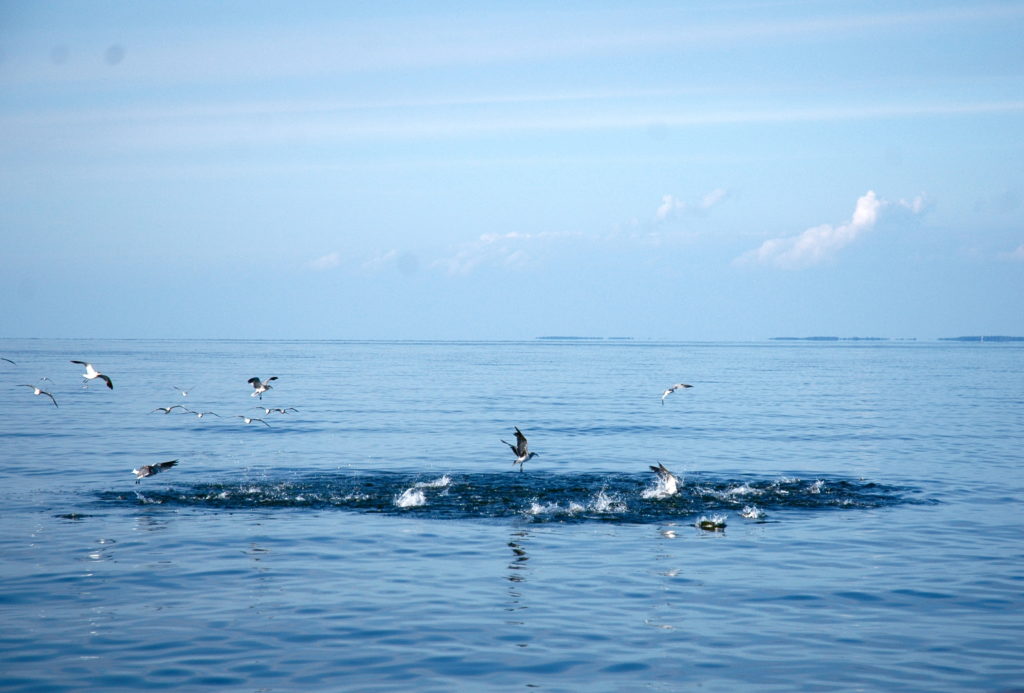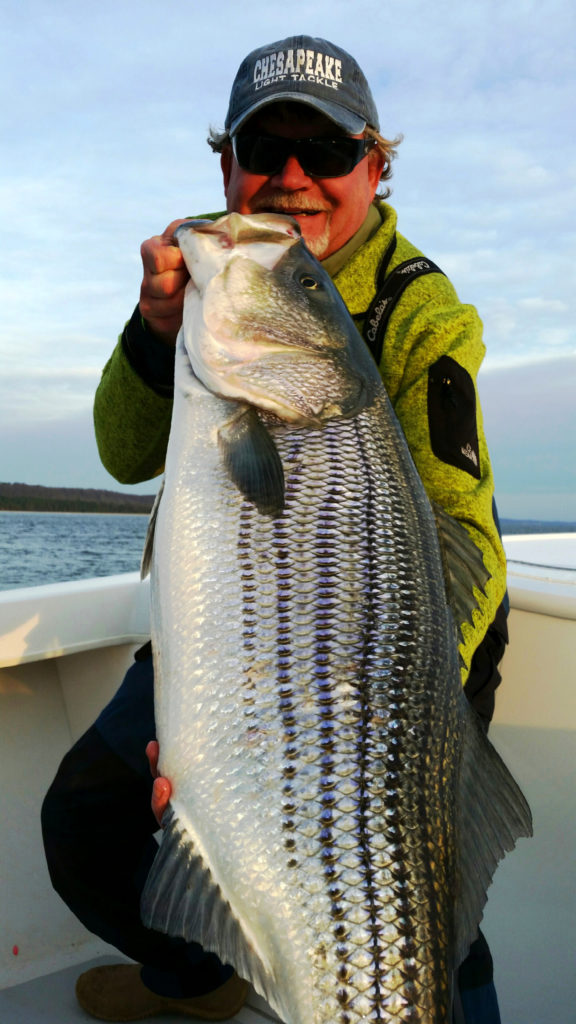Restoration efforts have helped the Bay earn an above-failing grade, but the tiny fish at the base of the system weren’t even evaluated
There’s nothing more exciting to a Chesapeake Bay angler than to see working birds off in the distance. It almost always means good fishing is ahead.
“Find the bait and you’ll find the fish,” is a phrase my father taught me, and one I’ve since passed on to my children and grandchildren. It especially holds true here on the Chesapeake Bay. Running and gunning with my family in a fast, open boat, while scanning the horizon for swooping and diving birds, is one of my favorite ways to spend a day on the water.
When rockfish are actively feeding, they push baitfish like bay anchovies and menhaden up to the surface. Sometimes the fish smash the hapless minnows a foot or more into the air. That makes them easy picking for the frenzied birds, which get so worked up that they’ll even take the bait right out of a fish’s mouth. Casting a brightly-colored lure into the melee will almost always catch fish.

Throughout the year I host fishing seminars in the Chesapeake Basin to give tips and advice on how to target rockfish. At one of my recent seminars, an angler asked for my thoughts on the most important environmental factors that contribute to good fishing. I rattled off four of them: bait fish, water quality, habitat, and the abundance of gamefish. It’s impossible to look at any one factor as more important than the others because they are all so intertwined—really good fishing in the Chesapeake Bay depends on the health of the entire ecosystem.
That’s why I follow The University of Maryland Center for Environmental Science’s annual Chesapeake Bay report card with such interest. The goal is to evaluate all of those factors, and more, when assessing the health of the Bay.
It’s time to get serious about our Chesapeake Bay ecosystem and the shared resources we all enjoy. Click To TweetThis year, the Center gave my treasured estuary an overall grade of ‘C.’ That’s average—better than failing, but hardly cause for celebration. That’s why I was surprised to hear the cheers coming from some of our government agencies and environmental support groups. I know we’ve made progress, especially in areas like improved water clarity and bay grass growth, but a ‘C’ is still so far from where we need to be.
It’s right to take credit for improvements, but instead of cheering, we should see this average grade as a reminder of the challenges we face—and how much more work there is to be done.
At the same time, the report card gave Chesapeake Bay fisheries a surprisingly high grade of 90 percent, despite a general consensus among recreational fishermen that the spring 2017 trophy striped bass season was the worst in recent memory. Many anglers I talk with say big fish catches have been declining steadily in the past decade, which makes the report card’s failure to evaluate the strength of the menhaden population—the stripers’ main food source—all the more puzzling.

It’s inconceivable that an otherwise comprehensive assessment of the Bay’s ecosystem would not include an accounting for what has been described as “the most important fish in the sea.” Menhaden are the favorite forage fish for mature rockfish, and a vital component of the Chesapeake Bay’s ecosystem. In addition, menhaden are literally water cleaning machines. While eating plankton that causes algae blooms, one adult menhaden can filter 2.4 gallons of water every minute.
The link between healthy and abundant menhaden stocks and plentiful rockfish and other popular sportfish is undeniable, which is why sportfishing groups and anglers have been pushing federal and state fisheries managers for more than a decade to consider regulations that would help ensure abundant menhaden and other important forage stocks.
The Atlantic States Marine Fisheries Commission, the organization that manages our shared fisheries resources, is currently considering an ecosystem management amendment for menhaden. A new approach would factor in the menhaden’s critical role in the ecosystem as prey and efficient water cleaners. This is an effort that recreational anglers up and down the East Coast should support.
The effort to conserve menhaden has been a long and arduous process, but nearly every indication of success has been undercut by constant pressure to increase the harvest for menhaden and striped bass. Managers must move beyond this one step forward, two steps back approach to ensure a brighter future for baitfish, the species they support, and the Bay’s fishermen.
Even as the ASMFC has conceded that the spawning stock biomass for striped bass is down, commissioners were faced with a proposal to increase the rockfish harvest. While that effort failed, it illustrates the clear pressure on the Commission to increase harvests, even when the news on fish populations isn’t all that great.
If we don’t stop looking past short-term economics and do a better job of protecting our big spawning-class rockfish and the bait they eat, we are headed for disaster.
It’s time to get serious about our Chesapeake Bay ecosystem and the shared resources we all enjoy. The Bay is being challenged on every front. My hat is off to the University of Maryland for the work they’re doing in evaluating the health of the Bay, but you won’t find me celebrating the overall ‘C’ grade or even that debatable ‘A’ for fisheries.
We can and must do better.
Shawn Kimbro is an avid recreational angler and the author of two books about fishing in the Chesapeake Bay. A frequent speaker to fishing clubs, environmental groups, and conservation organizations, he is recognized across the Chesapeake region as a leading voice for stewardship within the fishing community.





Excellent article.
Joe Evans and I have been friends for a long time, and he told me to check your article. I would like suggstions for how I can help with respect to bunker. And a “C” is “Poor” in my book. regards, Kin
Kin- contact me at jgans@trcp.org for ideas on how to help on bunker
We recently had a forage fish bill pass here in Washington State. Our legal situation is a bit different given the Bolt decision, but you might want to check in with the environmental and fishing groups here. As I recall, it met almost no resistance.
Find the Bait.
I recommend that everyone read “Running Silver: Restoring Atlantic Rivers and Their Great Migrations” by John Waldman. You will learn so much about this history of fish and fishing on the Eastern Seaboard. You will learn how far we have fallen, how much destruction has occurred to fish stocks. It might even make you cry. Of course forage fish need to be evaluated and PROTECTED.
> I recommend that everyone read “Running Silver: Restoring Atlantic Rivers and Their Great Migrations” by John Waldman.
I just finished reading it — thanks for the recommendation. Too sad to read in some ways, but important to know about.
PLEASE HELP stop the NEEDLESS destruction of our world in any way you can…It’s my belief there will be ONLY so many seats on the vehicle “the rich and successful” will be taking , after they destroy this world !!!
Mid Atlantic coast is being systematically stripped of bunker (menhaden to you) by factory fishing for animal feed protein.
Hi Sean and TRCP,
I work for UMCES – in the lab that creates the Chesapeake Bay Report Card. I stumbled across your article in my dentist office while reading an old copy of Chesapeake Bay Magazine. We wanted to let you know that we appreciate the input about the report card needing more forage fish indicators, specifically looking at Atlantic Menhaden. During the course of re-vamping the report card over the next few years we hope to be able to find the correct data and way of evaluating the health of menhaden and other important forage fish in order to include them in the report. It’s truly a tough job to evaluate the ecosystem as a whole but we do agree that we are missing an important part of the picture – we just haven’t had the data to include in the assessment yet. Regardless, we thank you for your input and careful reading of our report. As a fisherman myself I know that menhaden are especially key for the health of bigger (read: fun to catch) species of fish that we want around our estuary, and personally would really love to include them in the report. Would love you to keep writing articles for other indicators or stories that you think we are not hitting the mark on in our assessment.
Kind regards,
UMCES Integration and Application Network